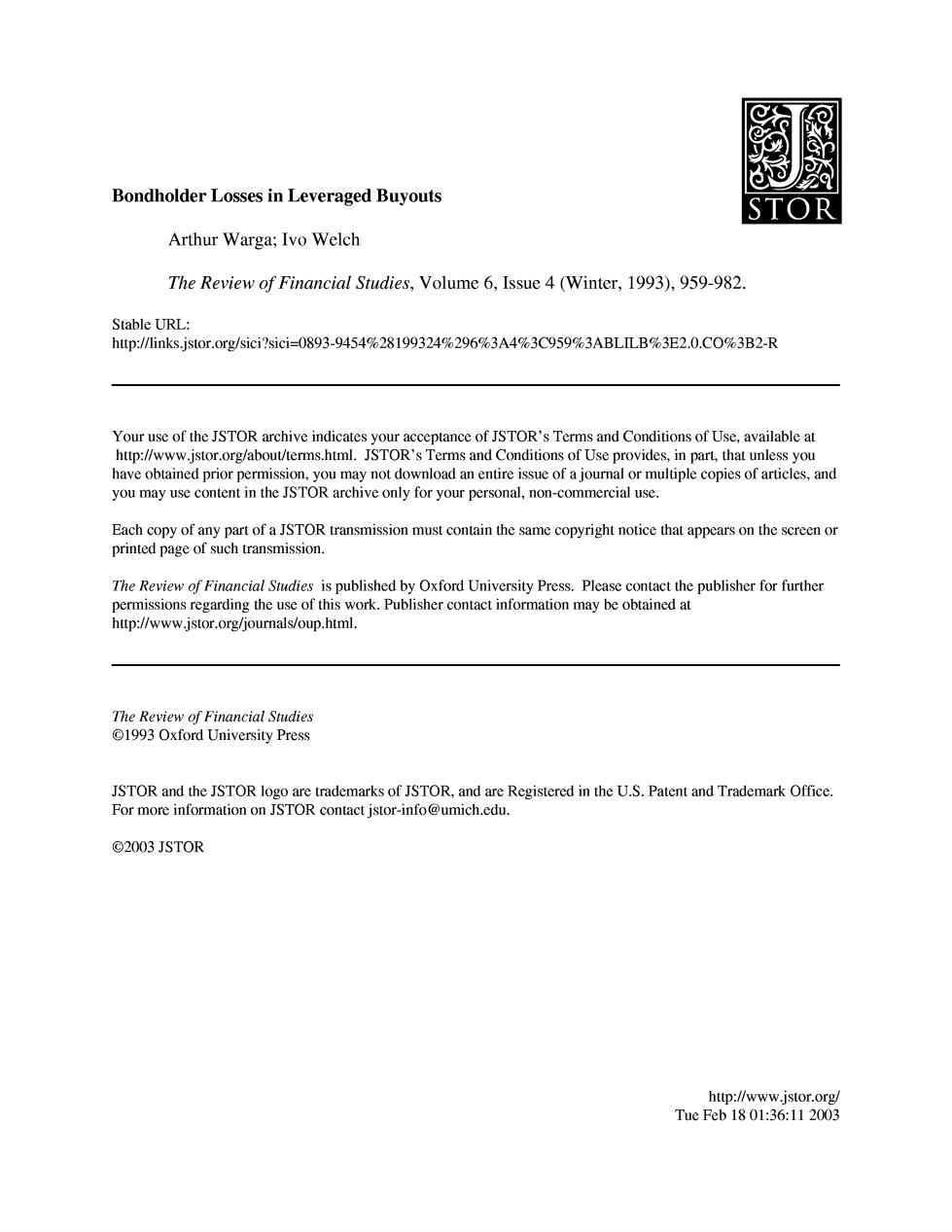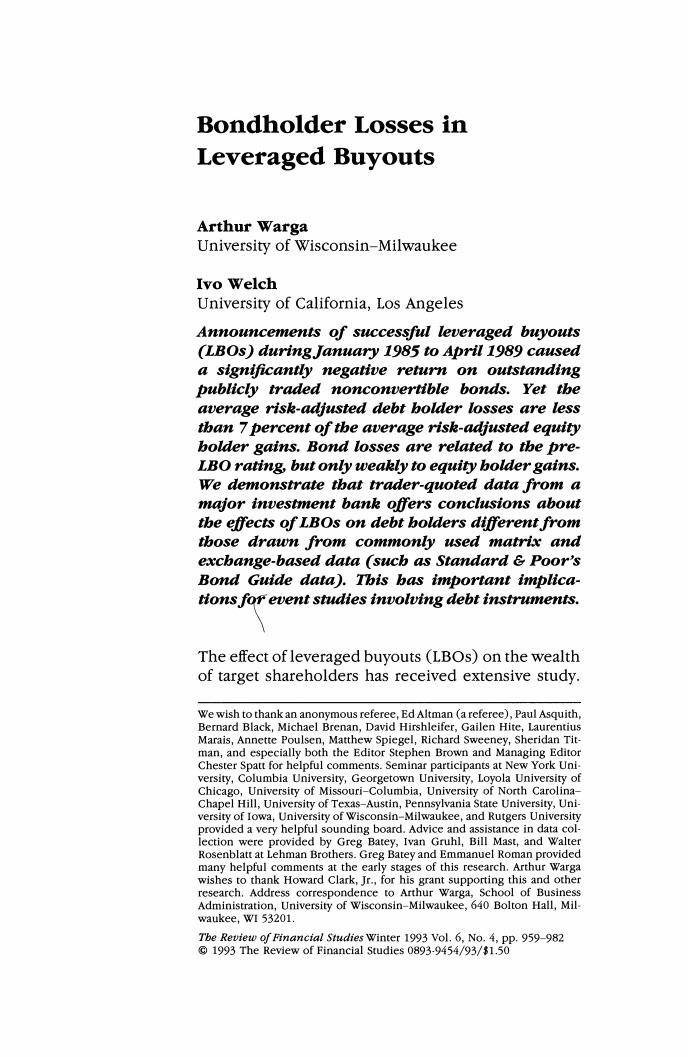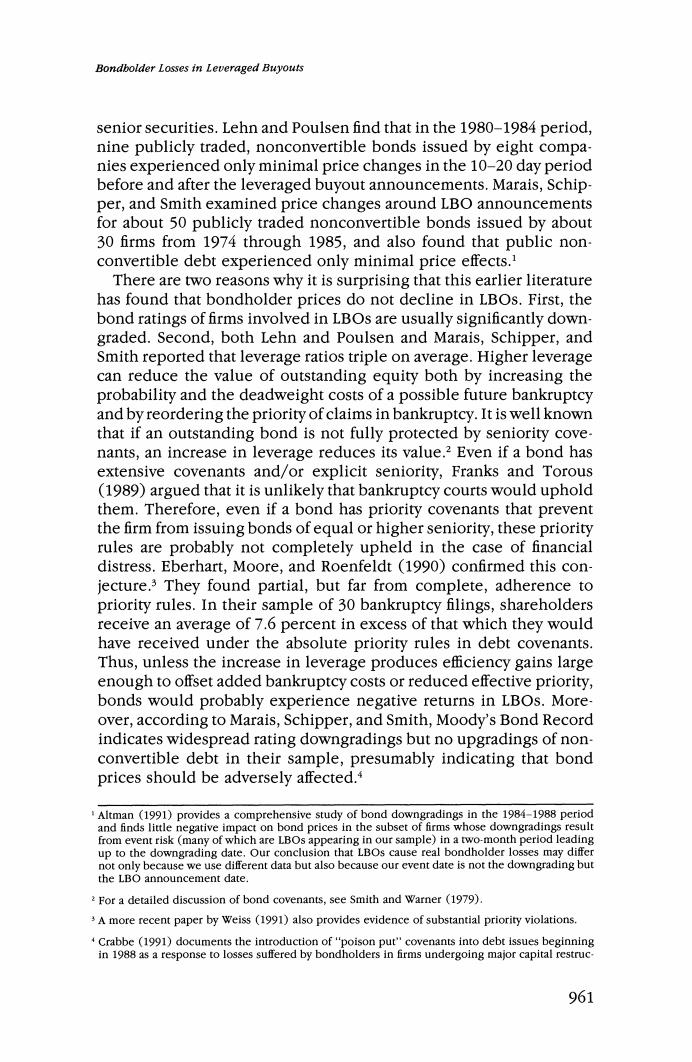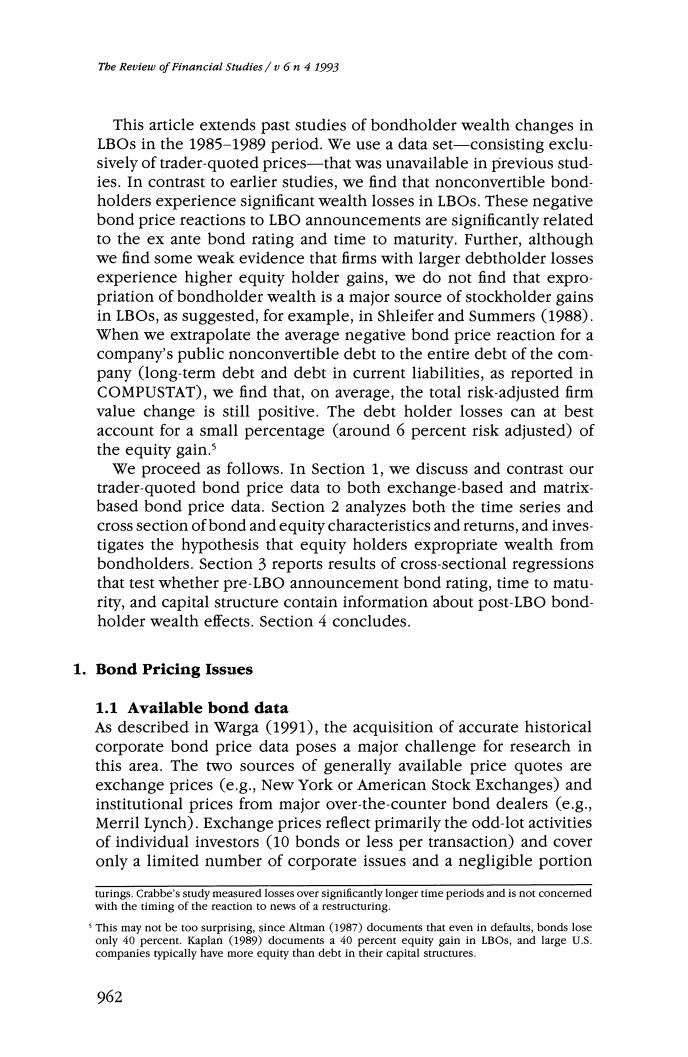
Bondholder Losses in Leveraged Buyouts STOR Arthur Warga;Ivo Welch The Review of Financial Studies,Volume 6,Issue 4 (Winter,1993),959-982. Stable URL: http://links.jstor.org/sici?sici=0893-9454%28199324%296%3A4%3C959%3ABLILB%3E2.0.CO%3B2-R Your use of the JSTOR archive indicates your acceptance of JSTOR's Terms and Conditions of Use,available at http://www.jstor.org/about/terms.html.JSTOR's Terms and Conditions of Use provides,in part,that unless you have obtained prior permission,you may not download an entire issue of a journal or multiple copies of articles,and you may use content in the JSTOR archive only for your personal,non-commercial use. Each copy of any part of a JSTOR transmission must contain the same copyright notice that appears on the screen or printed page of such transmission. The Review of Financial Studies is published by Oxford University Press.Please contact the publisher for further permissions regarding the use of this work.Publisher contact information may be obtained at http://www.jstor.org/journals/oup.html. The Review of Financial Studies 1993 Oxford University Press JSTOR and the JSTOR logo are trademarks of JSTOR,and are Registered in the U.S.Patent and Trademark Office. For more information on JSTOR contact jstor-info@umich.edu. ©2003 JSTOR http://www.jstor.org/ Tue Feb1801:36:112003

Bondholder Losses in Leveraged Buyouts Arthur Warga University of Wisconsin-Milwaukee Ivo Welch University of California,Los Angeles Announcements of successful leveraged buyouts (LBOs)during January 1985 to April 1989 caused a significantly negative return on outstanding publicly traded nonconvertible bonds.Yet the average risk-adjusted debt bolder losses are less than 7 percent of the average risk-adjusted equity bolder gains.Bond losses are related to the pre- LBO rating,but only weakly to equity bolder gains. We demonstrate that trader-quoted data from a major investment bank offers conclusions about the effects of LBOs on debt bolders different from tbose drawn from commonly used matrix and excbange-based data (sucb as Standard Poor's Bond Guide data).Tbis bas important implica- tions for event studies involving debt instruments. The effect of leveraged buyouts (LBOs)on the wealth of target shareholders has received extensive study. We wish to thank an anonymous referee,Ed Altman (a referee),Paul Asquith Bernard Black,Michael Brenan,David Hirshleifer,Gailen Hite,Laurentius Marais,Annette Poulsen,Matthew Spiegel,Richard Sweeney,Sheridan Tit- man,and especially both the Editor Stephen Brown and Managing Editor Chester Spatt for helpful comments.Seminar participants at New York Uni versity,Columbia University,Georgetown University,Loyola University of Chicago,University of Missouri-Columbia,University of North Carolina- Chapel Hill,University of Texas-Austin,Pennsylvania State University,Uni versity of Iowa,University of Wisconsin-Milwaukee,and Rutgers University provided a very helpful sounding board.Advice and assistance in data col- lection were provided by Greg Batey,Ivan Gruhl,Bill Mast,and Walter Rosenblatt at Lehman Brothers.Greg Batey and Emmanuel Roman provided many helpful comments at the early stages of this research.Arthur Warga wishes to thank Howard Clark,Jr.,for his grant supporting this and other research.Address correspondence to Arthur Warga,School of Business Administration,University of Wisconsin-Milwaukee,640 Bolton Hall,Mil- waukee,WI 53201. Tbe Review of Financial Studies Winter 1993 Vol.6,No.4,pp.959-982 1993 The Review of Financial Studies 0893-9454/93/$1.50

Tbe Review of Financial Studies/v 6 n 4 1993 The consensus of past work has been that equity holders receive substantial gains.There is considerably less agreement of the effect of LBOs on the wealth of target bondholders due to the lack of high- quality corporate bond data.By focusing on the issue of bond data sources,we demonstrate that studies that measure the timing and magnitude of security price reaction to recent information (e.g.,LBO announcements)can be sensitive to the type of data that is used.We find that LBOs cause real bondholder losses and that the main effect is concentrated at the time of the LBO announcement. Unfortunately,high-quality bond data are not always available.Most bond trading is carried out in the dealer market where prices are proprietary.Publicly available data,such as that produced by bond trades on the New York Stock Exchange,can be inadequate because these markets are extremely thin.Bond prices from commercial ser. vices that purport to be based on the dealer market are usually tied to an algorithm that does not always incorporate recent information. Although Warga (1991)finds that dealer and exchange-based data sources provide similar prices for large portfolios under normal cir- cumstances,this article shows that high-volume dealer market prices can show important differences in event studies.We find that our dealer market yields react not only sooner than exchange-based yields, but they also show statistically and economically more significant effects.For example,in a current study on LBOs that relies on the s&P bond data,Asquith and Wizman (1990)find an average four- month LBO risk-adjusted announcement bondholder return of-3.2 percent.In contrast,we document equivalent returns of-6.5 to -7.3 percent in the set of overlapping bonds for which the Asquith and Wizman data suggests a-3.8 percent return.Moreover,if we either properly aggregate returns among correlated bonds or if we exclude R.J.R.Nabisco,the S&P data (unlike the trader-quoted data used in this paper)no longer suggest a significant loss of bondholder wealth. Of course,the effect of LBOs on the wealth of bondholders is an interesting issue in its own right and must be addressed to determine the effect of LBOs on total firm value.It has been suggested in aca- demic studies [e.g.,Shleifer and Summers (1988)],as well as in the popular press,that the gains obtained by stockholders may be largely at the expense of bondholders;that is,net firm value may not change significantly.Counter to this argument are claims that improvements in operating efficiency or tax advantages [e.g.,Jensen (1986)]may increase the firm's total value and thus leave bondholders without any losses or,possibly,even with gains. Using exchange data collected from the Wall Street fournal,Lehn and Poulsen (1988)and Marais,Schipper,and Smith (1989)first examined the effect of LBOs on the price performance of outstanding 960

Bondbolder Losses in Leveraged Buyouts senior securities.Lehn and Poulsen find that in the 1980-1984 period, nine publicly traded,nonconvertible bonds issued by eight compa- nies experienced only minimal price changes in the 10-20 day period before and after the leveraged buyout announcements.Marais,Schip- per,and Smith examined price changes around LBO announcements for about 50 publicly traded nonconvertible bonds issued by about 30 firms from 1974 through 1985,and also found that public non- convertible debt experienced only minimal price effects.1 There are two reasons why it is surprising that this earlier literature has found that bondholder prices do not decline in LBOs.First,the bond ratings of firms involved in LBOs are usually significantly down- graded.Second,both Lehn and Poulsen and Marais,Schipper,and Smith reported that leverage ratios triple on average.Higher leverage can reduce the value of outstanding equity both by increasing the probability and the deadweight costs of a possible future bankruptcy and by reordering the priority of claims in bankruptcy.It is well known that if an outstanding bond is not fully protected by seniority cove. nants,an increase in leverage reduces its value.2 Even if a bond has extensive covenants and/or explicit seniority,Franks and Torous (1989)argued that it is unlikely that bankruptcy courts would uphold them.Therefore,even if a bond has priority covenants that prevent the firm from issuing bonds of equal or higher seniority,these priority rules are probably not completely upheld in the case of financial distress.Eberhart,Moore,and Roenfeldt (1990)confirmed this con- jecture.3 They found partial,but far from complete,adherence to priority rules.In their sample of 30 bankruptcy filings,shareholders receive an average of 7.6 percent in excess of that which they would have received under the absolute priority rules in debt covenants. Thus,unless the increase in leverage produces efficiency gains large enough to offset added bankruptcy costs or reduced effective priority, bonds would probably experience negative returns in LBOS.More- over,according to Marais,Schipper,and Smith,Moody's Bond Record indicates widespread rating downgradings but no upgradings of non. convertible debt in their sample,presumably indicating that bond prices should be adversely affected. Altman (1991)provides a comprehensive study of bond downgradings in the 1984-1988 period and finds little negative impact on bond prices in the subset of firms whose downgradings result from event risk (many of which are LBOs appearing in our sample)in a two-month period leading up to the downgrading date.Our conclusion that LBOs cause real bondholder losses may differ not only because we use different data but also because our event date is not the downgrading but the LBO announcement date. 2 For a detailed discussion of bond covenants,see Smith and Warner (1979) 3 A more recent paper by Weiss (1991)also provides evidence of substantial priority violations. Crabbe (1991)documents the introduction of"poison put"covenants into debt issues beginning in 1988 as a response to losses suffered by bondholders in firms undergoing major capital restruc. 961

The Review of Financial Studies /v 6n 4 1993 This article extends past studies of bondholder wealth changes in LBOs in the 1985-1989 period.We use a data set-consisting exclu- sively of trader-quoted prices-that was unavailable in previous stud- ies.In contrast to earlier studies,we find that nonconvertible bond- holders experience significant wealth losses in LBOs.These negative bond price reactions to LBO announcements are significantly related to the ex ante bond rating and time to maturity.Further,although we find some weak evidence that firms with larger debtholder losses experience higher equity holder gains,we do not find that expro- priation of bondholder wealth is a major source of stockholder gains in LBOs,as suggested,for example,in Shleifer and Summers (1988). When we extrapolate the average negative bond price reaction for a company's public nonconvertible debt to the entire debt of the com- pany (long-term debt and debt in current liabilities,as reported in COMPUSTAT),we find that,on average,the total risk-adjusted firm value change is still positive.The debt holder losses can at best account for a small percentage (around 6 percent risk adjusted)of the equity gain.3 We proceed as follows.In Section 1,we discuss and contrast our trader-quoted bond price data to both exchange-based and matrix- based bond price data.Section 2 analyzes both the time series and cross section of bond and equity characteristics and returns,and inves- tigates the hypothesis that equity holders expropriate wealth from bondholders.Section 3 reports results of cross-sectional regressions that test whether pre-LBO announcement bond rating,time to matu- rity,and capital structure contain information about post-LBO bond- holder wealth effects.Section 4 concludes. 1.Bond Pricing Issues 1.1 Available bond data As described in Warga (1991),the acquisition of accurate historical corporate bond price data poses a major challenge for research in this area.The two sources of generally available price quotes are exchange prices (e.g.,New York or American Stock Exchanges)and institutional prices from major over-the-counter bond dealers (e.g., Merril Lynch).Exchange prices reflect primarily the odd-lot activities of individual investors (10 bonds or less per transaction)and cover only a limited number of corporate issues and a negligible portion turings.Crabbe's study measured losses over significantly longer time periods and is not concerned with the timing of the reaction to news of a restructuring. This may not be too surprising,since Altman (1987)documents that even in defaults,bonds lose only 40 percent.Kaplan (1989)documents a 40 percent equity gain in LBOs,and large U.S. companies typically have more equity than debt in their capital structures. 962